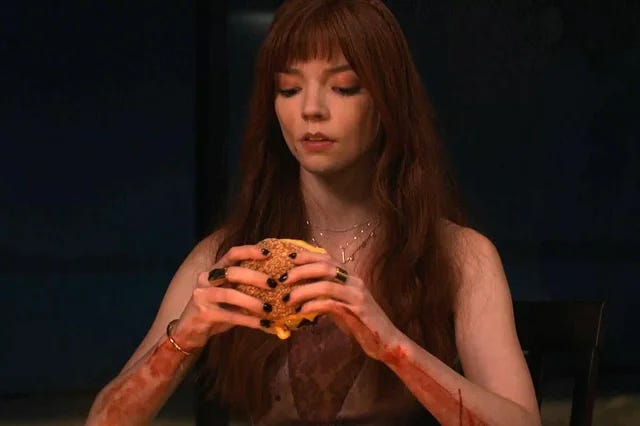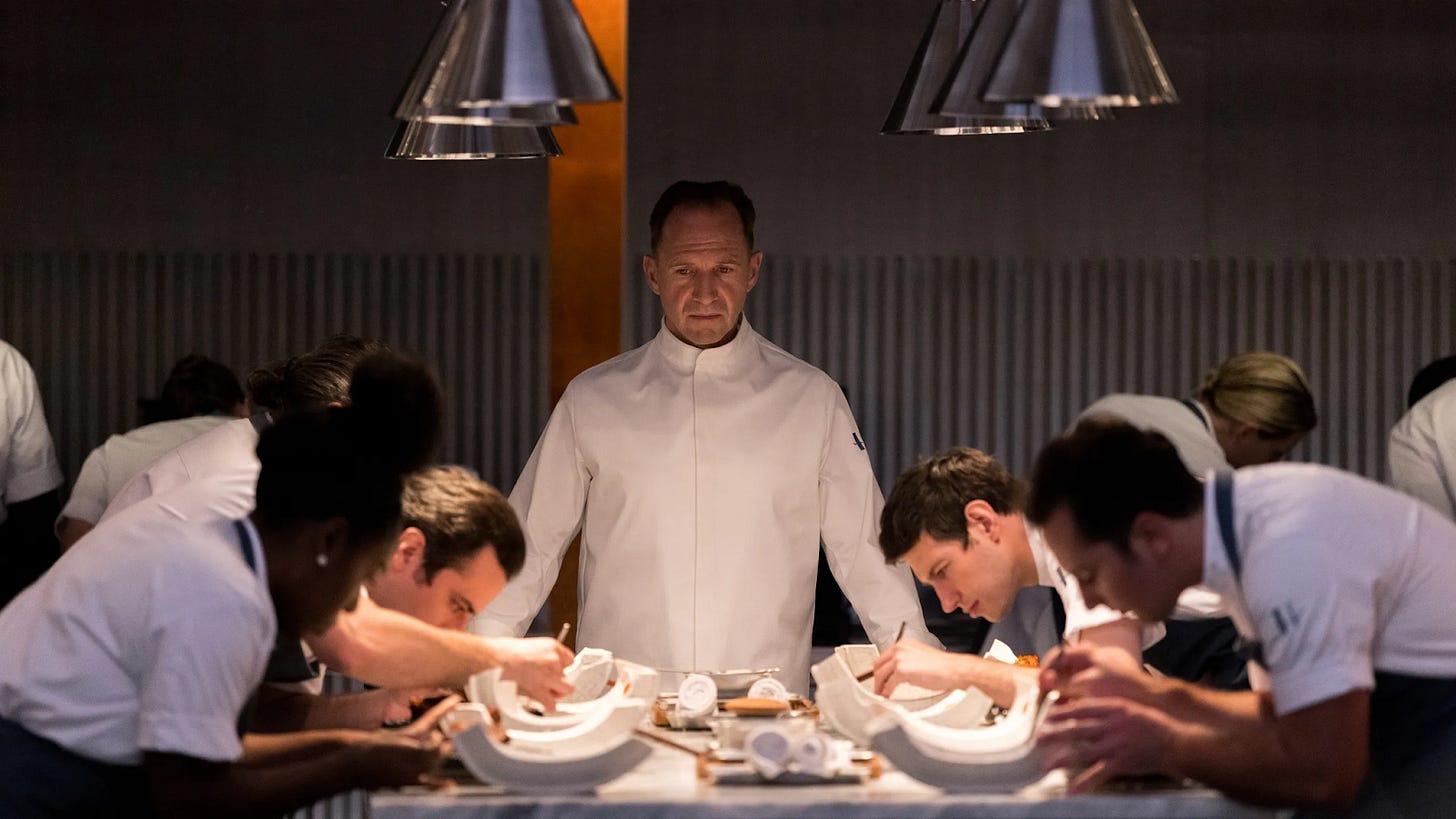I Can’t Believe it’s Not Rembrandt
GUEST ESSAY! B.J. Anderson “The Menu”, artificial intelligence, and the empty calories of slop culture
(This essay contains spoilers for “The Menu.”)
Did you catch “The Menu” when it came out a couple of years ago? The horror-comedy from director Mark Mylod begins with a simple enough premise: a world renowned chef has welcomed a group of people to his restaurant to experience a high concept, specially curated tasting menu- an exclusive evening of haute cuisine, admission to which is only possible by personal invitation. As dinner service is about to proceed, Chef Slowik (Ralph Fiennes) begs a favor of his hand-picked guests: “Do not eat… Taste. Savor. Relish. Consider every morsel that you place inside your mouth. Be mindful,” he asks, “But do not eat. Our menu is too precious for that.”
Having not yet been revealed to be the film’s antagonist, Chef Slowik comes off as intimidating yet warm, equal parts Gordon Ramsay and Anthony Bourdain. His request seems innocuous enough- even a little pretentious, maybe. This sort of “savor every bite” performative reverence is probably familiar to anyone who has ever had a friend that called themselves a “foodie”, and Chef Slowik’s dinner guests waste no time in living up to that stereotype. Dinner becomes an exercise in one-upmanship, with the guests using each carefully crafted course as an opportunity to flex their exquisitely refined palettes- a confluence of preening peacocks, too engrossed in their own sterling company to recognize the danger they’re in.
You see, the difference between the diners and their chef is that Chef Slowik’s appreciation of food is far from performative. The dinner guests have an approach to haute cuisine that might be described as top-down, an admiration for the expense and rarity of food as a product of social capital. There’s little recognition of the craft here, to say nothing of any real appreciation of the food itself. Slowik’s approach, on the other hand, is, and always has been, bottom-up- the view of a working class genius who has cultivated a genuine love of food and its preparation through years of study and practical application. For his wealthy patrons, food is status. For Slowik, it is art.
The fundamental incompatibility of these viewpoints is what drives Chef Slowik to enact his plan: this evening of fine dining is actually a trap carefully constructed to snare, and ultimately kill, those he perceives as having disrespected and debased the craft he’s spent a lifetime perfecting. To be clear, it’s not a gambit he intends to survive- what purpose could there be in continuing to live in a world so cruel? Better to end on his own terms, while delivering the most devastating parting shot of which he is capable.
The twist comes near the end; one of the diners, Margot (Anya Taylor-Joy), is able to spot Slowik as a fellow survivor of the societal ladder’s lower rungs- another “real” person in a room full of fakes. She accuses him of no longer cooking with love, in pursuit of satisfaction for the eater, but rather with obsession, in pursuit of nothing at all. She then declares that the evening’s dinner service has left her unsatisfied and hungry, and subsequently challenges Slowik to reconnect with his lost roots by making her a cheeseburger- “A real cheeseburger,” she suggests, “Not some fancy avant-garde bullshit.”
Moved by this moment of human sincerity, Chef Slowik obliges, and it’s notable that the process of preparing this humble meal, this traditional cheeseburger that, in his words, “will make you feel as if you are eating the first cheeseburger you ever ate, the cheap one your parents could barely afford,” is the one time we see him prepare something personally. Throughout the film, the actual cooking is delegated to his kitchen staff, but this last act is for him alone- and fittingly, it’s the only time in the film we see him genuinely happy.
For giving him that last instance of creative satisfaction, and out of solidarity for their shared social background, Slowik spares Margot, allowing her to flee the restaurant before the dinner’s finale: a dessert course that will kill everyone present with high explosives. It’s a devastating final statement from an artist who pushed back hard at the forces of disillusionment before finally breaking against them.
The ending is dark, certainly, and the bleakness of it may account for the film’s initial reception on social media being somewhat lukewarm, and even hostile. Professional critics were generally kind to the film, but the film hobbyists and casual moviegoers of Twitter (it hadn’t yet undergone its Jekyll/Hyde transformation into X) blasted “The Menu” as “pretentious”, “self-important”, and “mean spirited.” It’s not uncommon for there to be a divide in perception between film critics and moviegoers- taste is a matter of subjective opinion, and it may well be the case that “The Menu” does deserve those descriptors, and more besides.
There was always an underlying edge to certain kinds of criticism that the film got, however- a certain aggrieved tone that suggested the film’s premise had been taken as a personal attack. Underneath the veneer of film language and internet hyperbole, there seemed to bubble the suggestion that an artist being unhappy with commercial success was a ridiculous, insulting premise.
This idea, seeming at the time to be an odd outlier in film criticism, has, surprisingly, emerged as a common thread in the ongoing discussion around AI. In the two years since “The Menu” came out, the Internet has seen the rapid advancement of generative AI technology, as well as its integration into nearly every facet of our digital lives.
Creatives of all types have been persistent in their objections to this technology, citing the fact that learning models scrape data without consent, stealing works whole-cloth for unethical reproduction to produce results that are largely plagiarized. AI advocates have responded to these criticisms with defensive accusations of “gatekeeping”, and even spiteful glee at the suggestion that the ability to churn out derivative slop for “free” spells the end for any sort of paid creative profession. Corporations, slavering at the pie-in-the-sky notion of infinite growth with zero financial outlay, have begun to follow suit, laying off creatives in favor of AI generated garbage. The results have been predictably poor.
This attitude- professional envy and bone-deep entitlement walking hand-in-hand with casual disrespect and plain old human greed- has become the rallying cry of the AI Tech Bro in 2024. Industry giants press on with their implementation of the unproven technology, followed closely by a small army of tech bro-adjacent orbiters who are only too happy to fellate their chosen king’s ego with a soothing echo chamber of “well done, sir”s. Temporarily Embarrassed Millionaires that they are, these toadies carry the banner with doglike eagerness, proudly declaring their intent to keep using generative AI tools regardless of the human or environmental cost, jeering with undisguised delight at artists that express frustration with their inability to protect their work from being stolen.
The idea that art only has value insofar as it can be made profitable is the engine that powers generative AI. By removing the human element, the production cost of art is reduced to zero, making it profitable almost by default… But only in theory. In practice, profit is only generated if customers want to buy the product, and no one seems to want anything produced by AI, because AI can’t make anything new- it can only reproduce the data it has been fed, which means the output of any generative AI model will only ever be a worse version of something that already exists.
Silicon Valley hasn’t yet produced a generative AI model capable of iterating- instead, the models spew slop, and as the tech bros wanted, they do so cheaply. Financially, ethically, spiritually, it is cheap- and despite the fact that it doesn’t seem to be delivering on the second half of that magic equation of profitability, it is now flooding every conceivable corner of the Internet. Despite the fact that it is unprofitable, unattractive and generally unwanted, it is becoming unavoidable.
In the face of such an onslaught, one begins to understand Chef Slowik’s position.
A slow, steady force of anti-intellectualism has waged a long campaign against curiosity in this country, and we are beginning to see that imagination will be one of the first true casualties. Without the curiosity to imagine, art can have no use beyond the transactional. Beauty, insight, purpose- in the mind of the incurious, these things have little utilitarian function, because they have no definite monetary value. There is, therefore, no need for these things when engaging in creative pursuits, no reason not to skip directly to the part where a product can be sold.
The AI slop that surrounds us is cultural margarine- possessing some of the qualities of the thing it imitates, in an academic sense, but ultimately unable to replicate the flavorsome nature of the genuine article. All of the aesthetics, none of the human spirit. I Can’t Believe it’s Not Rembrandt.
In hindsight, “The Menu” seems oddly prescient. In seeing his life’s work reduced to magazine blurbs, Instagram posts and so much meaningless cultural clout, Chef Slowik caught a glimpse of the post-AI world- all art reduced to Product, consumed without thought, and forgotten just as quickly. He was presented with the premise that widespread commercial success is the ultimate ‘goal’ of art, and he rejected it- along with it the suggestion that there is any real satisfaction to be had in amassing wealth through the commodification of the human soul. Given the choice between shoveling slop and non-participation, he chose the latter.
May we all be so courageous.











I'm so enjoying this cultural future that does nothing but churn out an increasingly garbled pastiche of human creativity, year dot to 2020. As dead as that seems now, imagine 50 years of the same.
If you are a true artist AI can be used as a great jumping off point. Now if you are a true fraud and release what the AI hath created as thine OWN. Then you are should catch shit.
But, if you are able to use AI as just an idea or schematic generator and then branch off into your own thang that you augment into your own hybrid- much like Andy Warhol and Pop Art or the Found Art movement- I think AI is harmless. There hasn’t been anything really PURELY ORIGINAL in at least a decade or so.
This article though was very good food for thought- and I dug The Menu. It had more of a heart to it than people gave it credit for having.